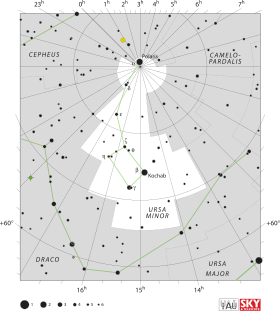Pi2 Ursae Minoris
Pi2 Ursae Minoris (π2 Ursae Minoris / π2 UMi) est une étoile binaire de la constellation circumpolaire de la Petite Ourse d'une magnitude apparente combinée de +6,95[2], ce qui fait qu'elle n'est pas visible à l’œil nu. Le système est distant d'environ ∼ 390 a.l. (∼ 120 pc) du Soleil[1], et il se rapproche du système solaire avec une vitesse radiale de −32,1 km/s[6].
| Ascension droite | 15h 39m 38,6083s[1] |
|---|---|
| Déclinaison | +79° 58′ 59,5799″[1] |
| Constellation | Petite Ourse |
| Magnitude apparente | 6,95[2] |
Localisation dans la constellation : Petite Ourse | |
| Type spectral | F1V[3] / + G0[4] |
|---|---|
| Indice B-V | 0,392 ± 0,015[5] |
| Vitesse radiale | −32,10 ± 1,8 km/s[6] |
|---|---|
| Mouvement propre |
μα = −32,92 mas/a[1] μδ = 40,28 mas/a[1] |
| Parallaxe | 8,33 ± 0,61 mas[1] |
| Distance | 390 ± 30 a.l. (∼ 120 pc) |
| Magnitude absolue | +1,51[5] |
| Luminosité | 16,5 L☉[7] |
|---|---|
| Température | 6,858 K[8] |
| Métallicité | 0,09 [Fe/H][9] |
| Âge | 1,20×109 a[9] |
| Composants stellaires | π2 UMi A, π2 UMi B[4] |
|---|
| Demi-grand axe (a) | 0,464 ± 0,083 ″ |
|---|---|
| Excentricité (e) | 0,961 ± 0,014 |
| Période (P) | 171,62 ± 8,68 a |
| Inclinaison (i) | 135,2 ± 10,5° |
| Argument du périastre (ω) | 274,0 ± 22,4° |
| Longitude du nœud ascendant (Ω) | 123,4 ± 32,6° |
| Époque du périastre (τ) | 1 904,15 ± 2,89 JJ |
Désignations
Les deux étoiles sont distantes en moyenne de 0,464 seconde d'arc dans le ciel, et elles effectuent une orbite l'une autour de l'autre avec une période d'environ 170 ans[4]. L'étoile primaire, désignée π2 Ursae Minoris A, est une étoile jaune-blanc de la séquence principale de type spectral F1V[3] et de magnitude apparente 7,32[11]. L'étoile secondaire, désignée π2 Ursae Minoris B, est une naine jaune de type G0[4] et de magnitude apparente 8,15[11].
Notes et références
modifier- (en) Cet article est partiellement ou en totalité issu de l’article de Wikipédia en anglais intitulé « Pi2 Ursae Minoris » (voir la liste des auteurs).
- (en) F. van Leeuwen, « Validation of the new Hipparcos reduction », Astronomy & Astrophysics, vol. 474, no 2, , p. 653–664 (DOI 10.1051/0004-6361:20078357, Bibcode 2007A&A...474..653V, arXiv 0708.1752)
- (en) E. Høg et al., « The Tycho-2 catalogue of the 2.5 million brightest stars », Astronomy & Astrophysics, vol. 355, , p. L27 (DOI 10.1888/0333750888/2862, Bibcode 2000A&A...355L..27H)
- (en) N. Ginestet, J. M. Carquillat et C. Jaschek, « Spectral classifications in the near infrared of stars with composite spectra. III. Study of a sample of 137 objects with the Aurelie spectrograph », Astronomy & Astrophysics Supplement, vol. 134, no 3, , p. 473 (DOI 10.1051/aas:1999444, Bibcode 1999A&AS..134..473G)
- (en) William I. Hartkopf, Brian D. Mason et Theodore J. Rafferty, « Speckle Interferometry at the Usno Flagstaff Station: Observations Obtained in 2003-2004 and 17 New Orbits », The Astronomical Journal, vol. 135, no 4, , p. 1334 (DOI 10.1088/0004-6256/135/4/1334, Bibcode 2008AJ....135.1334H, lire en ligne)
- (en) E. Anderson et Ch. Francis, « XHIP: An extended hipparcos compilation », Astronomy Letters, vol. 38, no 5, , p. 331 (DOI 10.1134/S1063773712050015, Bibcode 2012AstL...38..331A, arXiv 1108.4971)
- (en) J. Holmberg, B. Nordström et J. Andersen, « The Geneva-Copenhagen survey of the Solar neighbourhood II. New uvby calibrations and rediscussion of stellar ages, the G dwarf problem, age-metallicity diagram, and heating mechanisms of the disk », Astronomy & Astrophysics, vol. 475, no 2, , p. 519-537 (DOI 10.1051/0004-6361:20077221, Bibcode 2007A&A...475..519H, arXiv arXiv:0707.1891)
- (en) A. G. A. Brown et al. (Gaia collaboration), « Gaia Data Release 2 : Summary of the contents and survey properties », Astronomy & Astrophysics, vol. 616, , article no A1 (DOI 10.1051/0004-6361/201833051, Bibcode 2018A&A...616A...1G, arXiv 1804.09365). Notice Gaia DR2 pour cette source sur VizieR.
- (en) Caroline Soubiran et al., « The PASTEL catalogue: 2016 version », Astronomy & Astrophysics, vol. 591, , p. 7 (DOI 10.1051/0004-6361/201628497, Bibcode 2016A&A...591A.118S, arXiv arXiv:1605.07384)
- (en) L. Casagrande et al., « New constraints on the chemical evolution of the solar neighbourhood and Galactic disc(s). Improved astrophysical parameters for the Geneva-Copenhagen Survey », Astronomy & Astrophysics, vol. 530, no A138, , p. 21 (DOI 10.1051/0004-6361/201016276, Bibcode 2011A&A...530A.138C, arXiv 1103.4651)
- (en) * pi.02 UMi -- High proper-motion Star sur la base de données Simbad du Centre de données astronomiques de Strasbourg.
- (en) « Sixth Catalog of Orbits of Visual Binary Stars », United States Naval Observatory (consulté le )
Liens externes
modifier- (en) Pi2 Ursae Minoris sur la base de données Simbad du Centre de données astronomiques de Strasbourg.
- (en) Pi2 Ursae Minoris sur WikiSky: DSS2, SDSS, GALEX, IRAS, Hydrogène α, Rayon-X, Photo, Sky Map, Articles et images
